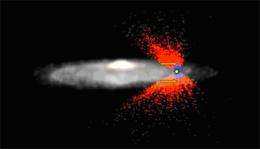Milky Way stars move in mysterious ways

Rather than moving in circles around the center of the Milky Way, all the stars in our Galaxy are travelling along different paths, moving away from the Galactic center. This has just been evidenced by Arnaud Siebert and Benoit Famaey, astronomers at the Strasbourg Astronomical Observatory, and by their colleagues in other countries. This strange behavior may be due to perturbation caused by the central bar and spiral arms of our Galaxy, forcing stars to leave their normal circular course and take an outward path.
Most galaxies, including our own Milky Way, are spiral-shaped and stars are distributed in a thin disk rotating around the galactic center, with areas divided into spiral arms or elliptical regions such as the central bar. Due to gravity, the spiral arms move through the disk in the form of density waves. For over twenty years, scientists believed that the potential impact of these density waves on stellar velocities in the Milky Way was insignificant in comparison with the circular motion of the stars in the galactic disk. This belief has now been blatantly proved wrong by an international team including several researchers from the Strasbourg Astronomical Observatory: near the Earth, stars move towards the exterior of the Galaxy at an average speed of around 10 kilometers per second, which is considerably faster than previously thought.
To reach this conclusion, the team systematically analyzed the velocities of over two hundred thousand stars located within a radius of a little over six thousand light years around the Sun. Using data from the major star survey RAVE (RAdial Velocity Experiment) collected since 2003 by the Australian Astronomical Observatory's Schmidt telescope, they were able to measure for the first time the radial velocities of hundreds of thousands of stars and determine whether they were moving towards or away from us.
The researchers were thus able to ascertain that the average speed of stars towards the exterior of the Galaxy increases with their distance from the Sun in the direction of the Galactic center, reaching 10 kilometers per second at a distance of 6,000 light years from us (in other words, 19,000 light years from the Galactic center). This result was completely unexpected and all the more surprising as it appeared to mainly affect old stars, several billion years old. Until now, it was thought that the spiral arms mostly affected the dynamics of young stars (only a few tens-of-million-years old). However, theoretical study of the combined effect of the spiral arms and the central bar, both within and outside the plane of the Galaxy, could explain the strange distortions of stellar motion observed by the astronomers in the RAVE team. Watch this space!
More information:
“Detection of a radial velocity gradient in the extended local disc with RAVE,” Arnaud Siebert, et al., to be published in Monthly Notices of the Royal Astronomy Society.
The RAVE experiment: rave-survey.org/
Provided by CNRS



















